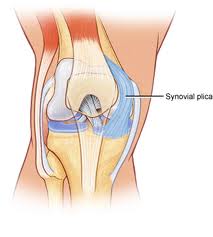Plica Syndrome
By Jesse L. Pace, DO and Asheesh Bedi, MD
Last Updated on October 23, 2023 by The SportsMD Editors
Plica syndrome is often characterized by anterior knee pain, which is most commonly found along the superomedial aspect of the knee. The “plica” is due to remnant embryological tissue that compartmentalizes the knee during fetal development. The plica is considered a “vestigial” structure, which means that it has lost its ability to function over time and does not functionally affect an individual whether it is present or absent. It has been likened to the appendix, which can be a source of pain but lacks significant important functions.
Symptoms
Usually plica syndrome is characterized by pain near the anteromedial (in front and toward the midline) side of patella (kneecap). Usually the pain is associated with bending of the knee and is irritated after and during exercise. Usually, no other symptoms other than pain is present, but it can occasionally be accompanied by swelling of the knee after prolonged physical activity.
Diagnosis for plica syndrome

Plica syndrome is a difficult diagnosis in athletes, and is often made after “exclusion” of other common, structural causes of knee pain. Athletes will typically complain of discomfort along the front or inside of the knee. Usually there are no “mechanical symptoms” of locking or catching with a plica, but a sense of snapping or catching from a large plica can rarely occur. There may be tenderness in the region of the plica or medial femoral condyle where the plica is abrading the bone. Plain x-rays are usually normal. An MRI may show the plica on certain views, but is primarily useful to exclude bone bruises, meniscus tears, ligament injuries, and cartilage defects that can also cause similar pain and swelling of the knee joint. Routine labs are not beneficial to diagnose plica syndrome, but can help to identify other potential causes of knee pain.
Causes of plica syndrome
Most often plica syndrome is precipitated by a history of blunt trauma to the front of the knee or prolonged strenuous exercise. The plica is an embryologic remnant that is present throughout life, but is believed that a traumatic event or repetitive microtrauma is responsible for inciting inflammation and symptoms.
Treatment for plica syndrome
Usually the first line of treatment for plica syndrome in athletes includes rest from strenuous or precipitating activities. Physical therapy can be initiated to strengthen and stretch the muscles and soft tissues around the knee. In addition, oral non-steroidal anti-inflammatory medications and steroid injections can help alleviate the symptoms of plica syndrome by decreasing inflammation and synovitis. If symptoms of pain and swelling completely resolve, a gradual rehabilitation program is started with a controlled return to competition. Steroid injections should be used judiciously, however. Occasionally, athletes may have a “flare” reaction after the injection with increased pain and swelling in the knee joint that resolves after 48 to 72 hours. Diabetics may have to monitor their blood sugar levels more closely due to a risk of hyperglycemia. In addition, there is a small risk of local “fat atrophy” and slight skin discoloration at the site of the injection.
Plica Syndrome Exercises
Surgery options
Failure to respond to months of nonoperative management may be an appropriate indication for surgical treatment in athletes. This procedure can be performed in a minimally invasive fashion (“arthroscopically”), using a camera and small instruments to excise the plica and associated inflammatory tissue around it that is causing the pain. The arthroscopic procedure also offers the benefit of allowing a thorough inspection of the knee for any other injuries or offending structures that may be a source of pain in athletes. The procedure has been reported with successful outcomes, allowing athletes to return to their previous level of competition without discomfort. However, the accurate diagnosis of a symptomatic plica remains the predominant challenge – not its surgical treatment. Many athletes will have asymptomatic plicas on imaging studies or arthroscopy that may not be the predominant cause of knee pain.
Return to play after surgery
Arthroscopic surgery and plica excision is a relatively minor surgery. Unless associated procedures or repairs to knee ligaments or cartilage are required, a controlled rehabilitation program and quadriceps strengthening usually allows for an expeditious return to play 4 to 6 weeks after surgery.
Get a Telehealth Appointment or Second Opinion With a World-Renowned Orthopedic Doctor
 Telehealth appointments or Second Opinions with a top orthopedic doctor is a way to learn about what’s causing your pain and getting a treatment plan. SportsMD’s Telehealth and Second Opinion Service gives you the same level of orthopedic care provided to top professional athletes! All from the comfort of your home.. Learn more via SportsMD’s Telemedicine and Second Opinion Service.
Telehealth appointments or Second Opinions with a top orthopedic doctor is a way to learn about what’s causing your pain and getting a treatment plan. SportsMD’s Telehealth and Second Opinion Service gives you the same level of orthopedic care provided to top professional athletes! All from the comfort of your home.. Learn more via SportsMD’s Telemedicine and Second Opinion Service.
Questions and Answers
When discussing plica syndrome or any medical condition with a healthcare provider, it’s important to ask questions to gain a better understanding of your condition and potential treatment options. Here are some questions you can ask, along with potential answers:
- What is plica syndrome?
- Plica syndrome is a condition in which the plica, a fold in the synovial lining of the knee joint, becomes irritated, leading to pain and discomfort.
- What caused my plica syndrome?
- Plica syndrome can be caused by overuse, repetitive knee movements, injury, or inflammation.
- How was plica syndrome diagnosed in my case?
- Diagnosis often involves a physical examination, medical history, and imaging studies like an MRI.
- What symptoms should I expect with plica syndrome?
- Symptoms may include pain, clicking or snapping in the knee, swelling, and discomfort, especially during certain movements.
- Is treatment necessary for plica syndrome?
- Treatment depends on the severity of symptoms and their impact on daily life. Some cases may respond to conservative measures, while others may require more extensive interventions.
- What are the treatment options for plica syndrome?
- Treatment options include rest, physical therapy, anti-inflammatory medications, and, in rare cases, arthroscopic surgery to remove the irritated plica.
- How long will the recovery process take, and what can I expect during this time?
- Recovery time varies based on the treatment approach, but it typically takes several weeks to months. Physical therapy may be needed for rehabilitation.
- What restrictions or limitations should I expect during the recovery period?
- Your doctor will explain any limitations on activities to protect the knee during healing.
- What are the potential complications associated with treatment and recovery?
- Complications are generally minimal. Surgery may carry risks, such as infection or stiffness. Your doctor can provide more information.
- What is the long-term outlook for plica syndrome?
- With appropriate treatment and rehabilitation, many individuals experience a good recovery and return to their normal activities without persistent symptoms.
- Do I need a follow-up appointment, and when should it be scheduled?
- Establish a plan for post-treatment follow-up appointments to monitor your progress and make any necessary adjustments to your care.
Always consult with your healthcare provider for personalized answers to these questions, and feel free to ask additional questions or seek clarification on any points you don’t fully understand. Effective communication with your doctor is essential for your understanding and overall care.
References:
Ewing, JW. Plica: Pathologic or Not? J Am Acad Orthop Surg 1993;1:117-121.
Post, WR. Anterior Knee Pain: Diagnosis and Treatment. J Am Acad Orthop Surg 2005;13:534-543.

